

The Incredible Insects Of Aotearoa



A Bluff wētā sunning itself on rocks.



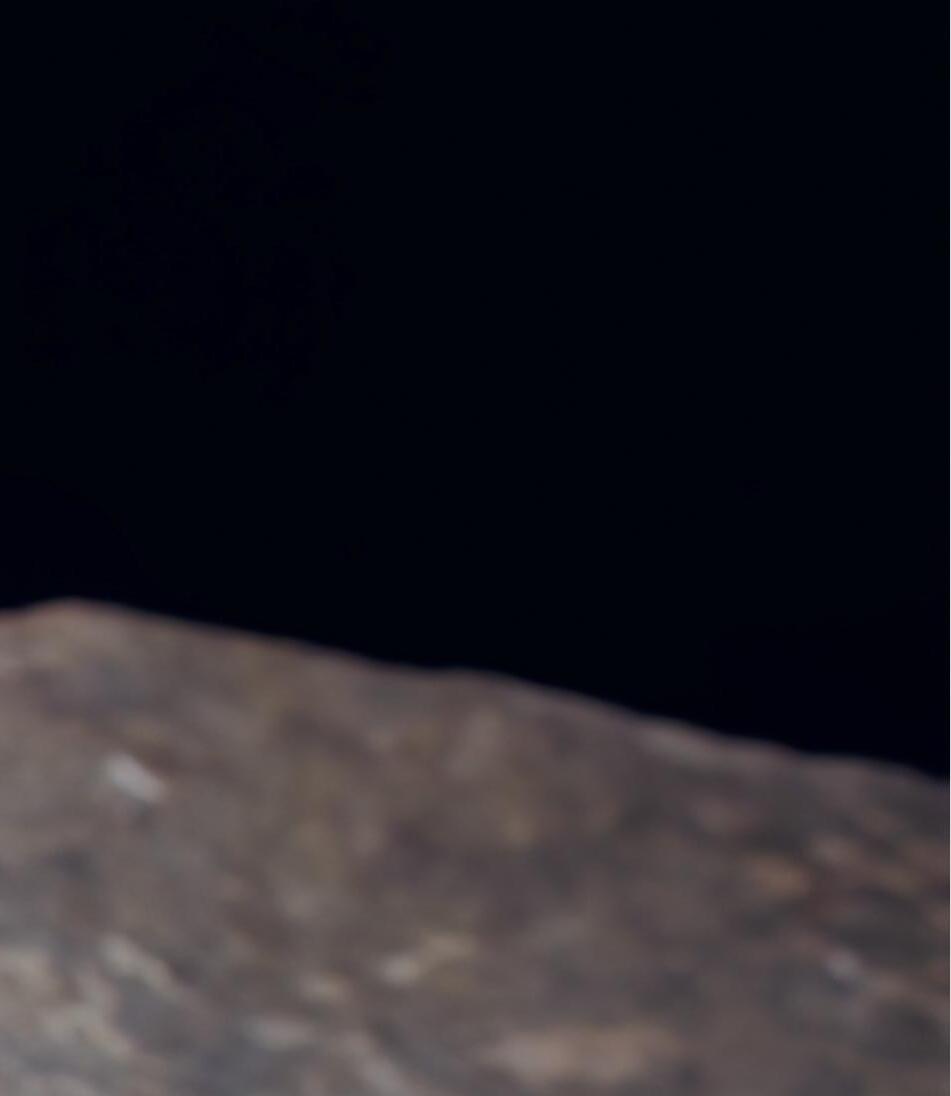
The Incredible Insects Of Aotearoa



SIMON POLLARD AND PHIL SIRVID


A hungry longhorn beetle.

A male Raukūmara wētā showing its elephant-like tusks.













There are thought to be around 20,000 species of insect in Aotearoa New Zealand. Over 90 percent of them are endemic, which means they are found nowhere else on Earth. Scientists know that there are still many more insect species that live here and have not yet been discovered. Many of our insects are strange and wonderful creatures with imaginative names. Although Aotearoa does not have elephants, it does have a beetle called an elephant weevil because of its trunk-like snout. It also has a gira e weevil, which, not surprisingly, has a long, slender body.
















We both loved writing our previous book, Why is That Spider Dancing? The Amazing Arachnids of Aotearoa, which allowed us to share the stories of the lives of those fantastical eight-legged animals. However, writing about arachnids wasn’t enough! We also wanted to tell the stories of the lives of some of their six-legged relatives, the incredible insects – and a couple of creatures with more than six legs – who share these islands with us. The stories of insects more than rival those of their arachnid cousins. It isn't possible to tell all the stories of the thousands of insect species living in Aotearoa. But we think the ones chosen for this book show just how special, extraordinary and worth finding out about our endemic insects are. We hope you agree.



















For example, the caterpillar of the gumleaf skeletoniser (what a great name for a



moth!) does something very strange each time it moults. It places its moulted heads on top of one another like a stack of hats. It is commonly called the ‘mad hatterpillar’. The male bat-winged fly has wings that make it look like a mini stealth bomber. Males of the similarly named (but very different-looking) bat fly can scream at the actual bats it lives with, to keep them away from the baby bat flies. However, one particular group of insects stands out in this book for being as iconic to Aotearoa as the kiwi or tuatara. These are our wonderful wētā that, as you’ll discover, are found in many different habitats. From our backyards to high in the mountains, down through forests to coastlines, underwater and in the darkness of caves, it’s time to meet the incredible insects of Aotearoa.
















Butterflies and moths

ngā pepe (Lepidoptera)


Key features: Insects with scale-covered wings. Adults generally have a coiled tube (called a proboscis) for feeding, although some species do not feed at all. Caterpillars have six true legs and several pairs of leg-like structures called prolegs.







Fascinating facts: Of the over 1700 species of New Zealand Lepidoptera, only around twenty-five are butterflies and the rest are moths. Wing scales can help these insects to escape spider webs. The scales can detach and are left stuck to the web instead of the main part of the wing.














Feeding method: Siphoning




Species known in Aotearoa: Over 1700


Caddisflies (Trichoptera)
Key features: Adult caddisflies resemble moths but have hairy wings, whereas moth wings are covered in scales. Caddisfly larvae are aquatic, and many species build shelters that are often carried and sometimes decorated with stones or algae.


Fascinating facts: The kind of caddisfly present in a stream can say a lot about how clean or polluted the water is. While caddisfly larvae are mostly found in fresh water, one New Zealand species lives in the sea.






Species known in Aotearoa: About 250


Feeding method: Chewing















Six legs but not officially insects
While it’s true that all insects have six legs, not everything with six legs is an insect. All the six-legged arthropods belong to a sub-phylum called Hexapoda (which means six-legged), but springtails (Collembola), coneheads, (Protura) and twopronged bristletails (Diplura) all have their mouthparts stored inside their heads, unlike insects that have them out in the open.
Most springtails have a tail-like projection called a furcula that is held locked and
folded against the body. When released, the furcula pushes against a surface to catapult the springtail to safety. It’s a great way to escape danger. Unsurprisingly coneheads have cone-shaped heads. They have no eyes or antennae and instead they use their first pair of legs to sense the environment. Two-pronged bristletails can look a lot like earwigs because of the two projections on the rear end, but unlike earwigs, they never have eyes or wings.
A two-pronged bristletail.
New Zealand giant springtails like this one are the largest springtails in the world!
A conehead.
Insects are found in all gardens, even in a hobbit’s garden here in Hobbiton, Matamata.















Homes and backyards








If you have been reading this book in your home or backyard, it is possible you have seen insects nearby as you turned the pages. In your backyard, you may be lucky enough to see a praying mantis or a stick insect trying to blend in with its surroundings. Our backyards are home to many different types of insects, some native and others introduced from other countries. It isn't possible to tell all of their different stories here, but hopefully the insects we have chosen will make you appreciate the incredible lives they lead, often unseen and right next to you.













The ‘wētātonians’ of Wellington


The Wellington tree wētā (Hemideina crassidens) lives in the lower part of Te Ika-a-Māui the North Island and the top of Te Waipounamu the South Island, and many call Te Whanganui-a-Tara Wellington home. If people living in the capital city are called Wellingtonians, that makes tree wētā ‘wētātonians’. This species has a cousin (Hemideina thoracica) found in the upper North Island, and those living in Auckland are known as the Auckland tree wētā. These two species of tree wētā both look quite similar, but the Wellington tree wētā stands out because of its flashy striped







◀ A wētā hotel waiting for guests.
▼ A male Wellington tree wētā (lower right) guarding females.




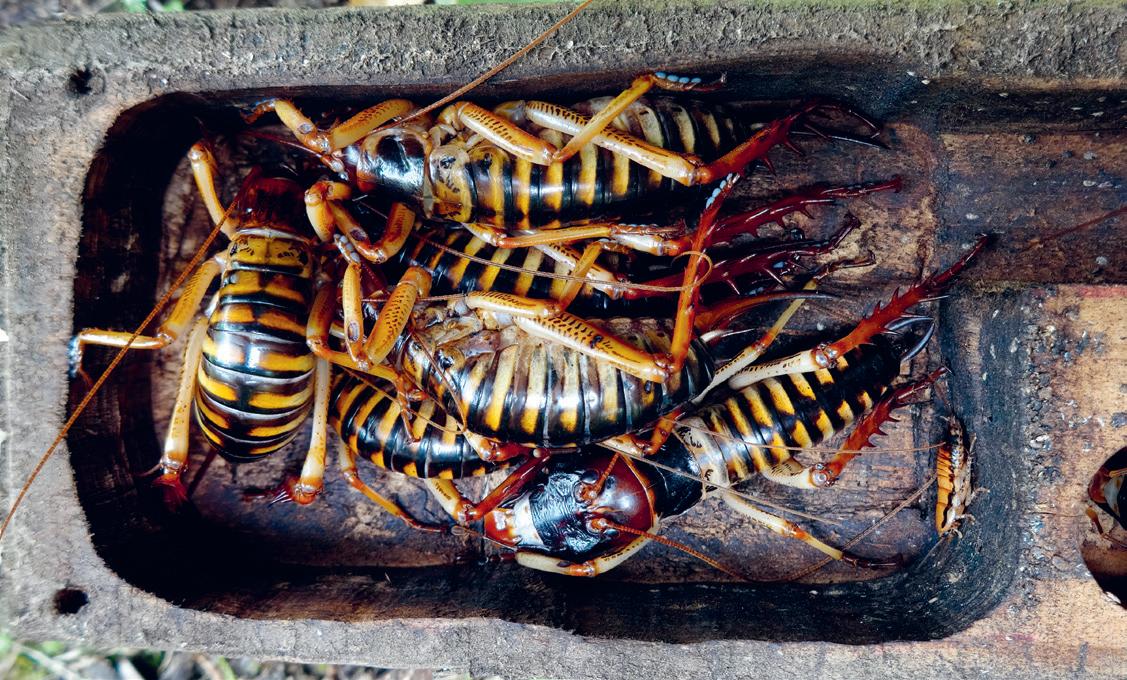














so the mantis nymphs (juveniles) develop more quickly than if they were in the shade. When the nymphs emerge from the egg case, they look like miniature versions of their mum and dad. When you look at an empty egg case, you can see the individual chambers the nymphs developed in.







We are very lucky to have such a fascinating predator living in our gardens, though their victims, like flies, are not so lucky. If flies could watch scary horror films, surely they would feature praying mantises as villains. Being snatched by a mantis must be one of a fly’s worst nightmares!







Hiding in plain sight



▼ A prickly stick insect in green camouflage.







Aotearoa is home to more than twenty stick insect species. Unlike many overseas species, ours are all flightless. Females of the bristly stick insect (Argosarchus horridus) can reach up to 200 millimetres long. This makes them our longest insects by far! Males are much shorter. Most animals need males and females to produce offspring, but not all stick insects do. Some females are parthenogenetic, meaning they don’t need a male to fertilise their eggs. Any eggs they lay will develop into females, like mini versions of their mum. Stick insects are famous for their ability to blend in with vegetation, looking,


























The New Zealand giant stick insect is the longest insect in Aotearoa.





Meet the Expert: Morgane Merien Science and Curatorial Communicator at Canterbury Museum











The insects I love the most are the stick insects. We have around twenty different species in Aotearoa New Zealand, found all over the country, from the coast to high up in the mountains. Stick insects are renowned masters of camouflage, able to blend into their environment by looking like sticks. This incredible superpower also extends to their behaviour. Not only do they look like a stick, but they also act like one. They put their front legs together to elongate their body and hang off branches to appear like the other twigs around them. With some species or particular populations of stick insects, you’ll only find females. They lay eggs that are clones of the mother, creating populations of just females – that’s true girl power! I also love the way they sway back and forth, dancing like a leaf in the wind. Stick insects may be hard to find, but keep looking and you might find yourself with a fascinating new friend!










▲ Morgane Merien holding three stick insects.

Alligator weed beetles nibbling on alligator weed.
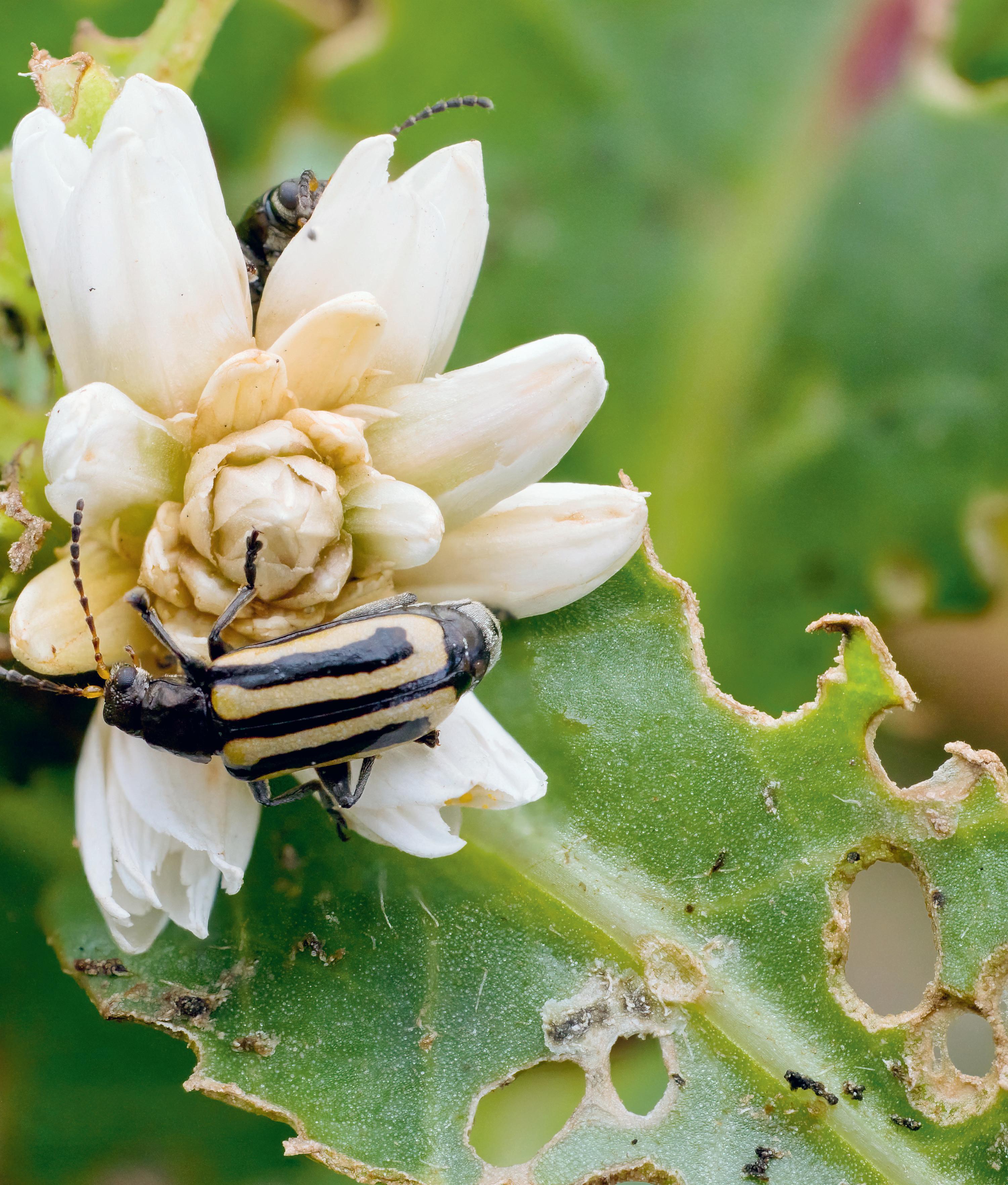
Caring for our incredible insects





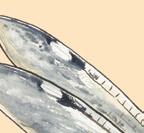








































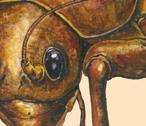
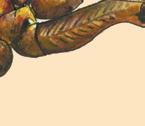
































Meet the Expert: Lily Duval
Artist, author and critter researcher




It’s strange to think that I didn’t like insects ten years ago. I used to find them unnerving and uninteresting (how wrong I was!). Now, my friends call me ‘the bug lady’ and send me regular texts asking me to identify invertebrates. These days, I’m a passionate advocate of our smaller, crawlier, overlooked fauna. I’m on a mission to turn people from entomophobes into entomophiles – from fearing insects to loving them.
I have written and illustrated my own book about insects, and I focus a lot on insects (and other invertebrates) in my art and writing. I especially love painting bugs, like those used on the cover of this book!
Since 2023 I’ve illustrated a poster for each annual Bug of the Year competition. The candidates include insects as well spiders, worms, and other invertebrates. It is run by the Entomological Society of New Zealand and voting starts every year on 1 January at bugoftheyear.ento.org.nz, so get involved!



















Spending hours staring at a critter is a great way to get to know it because the more you look, the more you see. I believe that the deeper you understand something, the more you love and appreciate it. The insect world is filled with a stunning variety of colours and forms, making them endlessly inspiring subjects. at to the that more world a Wētāpunga.



















































New Zealand antlion.
New Zealand giant stick insect.
Pūriri moth.
▲ Lily Duval in her garden studio.

























Tuning into Radio Wētā






The Cook Strait giant wētā (Deinacrida rugosa) had not been seen on the mainland for over one hundred years after it was wiped out by introduced mammals like rats and hedgehogs. Fortunately, some had survived on offshore islands around Cook Strait. To help this endangered wētā survive and breed in a safe place on the mainland, a number were taken to the Zealandia Te Māra a Tāne wildlife sanctuary in Wellington in 2007. The sanctuary is surrounded by a predator-proof fence, which meant the wētā were safe from mammals. Ten of the wētā were fitted with expensive radio transmitters, each weighing









▲ A giant wētā carrying a radio transmitter on its back.

less than a gram (which is less than the weight of a paperclip). Staff could then see how they moved around and adjusted to their new home.




One day, one of the transmitting female wētā, known to hide close to a stream, could not be found. Hoping to find her before the battery in her transmitter went flat, Zealandia staff refined their search –and discovered she was sending a signal from the middle of the stream. Maybe her transmitter had come loose and fallen in the water? They soon discovered that the radio transmitter was still attached to the









Simon’s pet elephant weevil (called Frank) showing how it got its common name. It’s huge!







Abdomen


WHAT DOES THAT WORD MEAN?


The rear part of the body of an insect.
Antennae





Chrysalis
A pair of structures on an insect’s head that help the insect sense the world around it. Often called feelers, antennae can be used to feel by touch, but they can also detect chemicals. Some insect antennae can detect air movements, vibrations and temperature.
Arthropods






A kind of pupa used by butterflies.
Citizen scientist


Meaning ‘jointed leg’, this is a broad group of animals (called a phylum) that all have an exoskeleton, including arachnids (e.g. spiders and scorpions), crustaceans (e.g. crabs and lobsters) and insects.
Binomial (scientific) name






A member of the public who helps support scientific research. They might do this by posting observations on iNaturalist, gathering data or collecting specimens for scientific projects.
Common name


A name that identifies a species using a combination of two names – its genus name (always starting with an upper-case letter) and its specific name (always starting with a lower-case letter). For example, the bristly stick insect’s scientific name is Argosarchus horridus. A species can only ever have one scientific name.
Cerci






A casual name for a species or a group of related species. Unlike scientific names, sometimes a species can have more than one common name. For example, the names mason bee and mason wasp are both used for the same species (Pison spinolae).
Compound eye





The main eyes of an insect, made up of many smaller units called ommatidia
Entomolgist
A person who studies insects and similar creatures.

Structures on the very rear of many insects. These come in many shapes and sizes and can have different roles. For example, earwig cerci are shaped like pincers and are used to grab prey, while cockroach cerci are short and pointed and can detect air movement and vibration.




Entomology
The study of insects.
Exoskeleton




A skeleton that is on the outside of the body.
Forcipules
Modified legs at the front of a centipede that are used to inject venom into prey.



Furcula
A fork-shaped tail-like structure found in springtails (Collembola). This is normally held
















WHO WROTE THIS BOOK?






Dr Simon Pollard





Simon wanted to study animals from the age of seven. When he was twenty, and studying zoology at the University of Canterbury, he became fascinated with the lives of spiders. He has been lucky to be able to study spiders all around the world, including blood-drinking spiders in Africa and fishing spiders in Borneo. Of all the different jungles he has been in, his favourite one is his garden at home. Here, he and his wife, Cynthia, can watch the animals who share their home and backyard as they go about their daily lives. Simon has been writing articles and books












about the natural history of animals for many years and is always amazed at what he learns about their world. In 2017, Simon was very pleased to learn he had a native jumping spider named after him. It is called Trite pollardi.

Dr Phil Sirvid



Phil has looked after the insect and arachnid collections at Te Papa for over thirty years. He was always interested in animals and got his start looking after emperor gum moth caterpillars for the










▲ Simon searching for insects in his garden.




















school nature table at the age of five. While other children wanted to become astronauts or firefighters when they grew up, Phil always knew he wanted to be a zoologist – although he briefly considered becoming a palaeontologist when he became aware of dinosaurs! Phil spent many summer days peering in rock pools as well as discovering the small creatures that lived in his garden. He studied zoology at Victoria University of Wellington and was taught entomology by George Gibbs, grandson of pioneering entomologist GV Hudson.























Simon and Phil have known each other for a long time and first worked together on an exhibition called Bug Lab, made in




collaboration between Te Papa and the award-winning Wētā Workshop. They enjoyed working together so much that they decided to write a book called Why is that Spider Dancing? The Amazing Arachnids of Aotearoa. While they would both call themselves ‘spider guys’, they have an abiding love of New Zealand’s special and unique insects and decided to write this book to share some of their favourite insect stories.











▲ Phil inspecting a velvet worm near Tennyson Inlet in Te Waipounamu.
THE INCREDIBLE INSECTS OF AOTEAROA
RRP: $35
ISBN: 978-1-99-107203-0
PUBLISHED: MAY 2025
PAGE EXTENT: 112 pages
FORMAT: Limpbound SIZE: 260 x 220mm
FOR MORE INFORMATION OR TO ORDER https://www.tepapa.govt.nz/about/te-papa-press/contact-te-papapress
